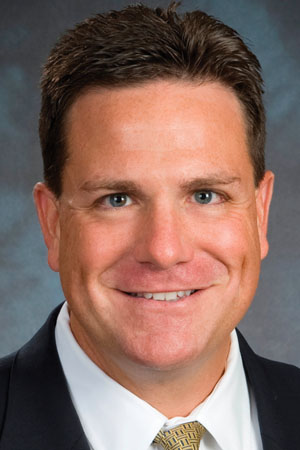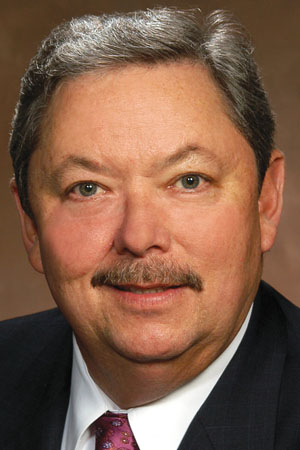After a rough, cat-filled 2011, how do commercial-lines carriersfeel about 2012? NU asked several key players for their perspectiveon which lines offer new opportunities; how they will expand theirdistribution channels; where carriers will be investing;and how they will handle relationships with risk managers as themarket hardens and rates increase for the first time in years.
| Scott Higgins
Scott Higgins
President
Travelers Commercial Accounts
2012 will be a challenging marketplace. The opportunities willbe for those insurance carriers that have the financial strength toinvest in the right products and services despite the challengesfacing the industry; and for those that can demonstratehigh-quality, price-effective services that are designed to meet orexceed our agents' and customers' unique and evolving needs.
|Travelers plans to set the pace in 2012. Our investments willfocus on providing our agents with product offerings for the manydiverse industries that make up our economy. We recognize that ourcustomers expect their trading partners to be experts in each oftheir industries—from coverage that's tailored to the unique needsof their businesses to dedicated claims and risk-controlprofessionals committed to delivering the very best customerexperience.
| Andrew Underwood
Andrew Underwood
Head of Specialty Division
Hiscox USA
Risks to businesses in the U.S. such as cyber security, socialmedia and legislative change continue to evolve on top of the morefamiliar, but not forgotten, threats to people and property. We'readdressing these emerging risks with dedicated industry forms andpackaged products to meet buyer demand—the opportunities in 2012belong to those insurers that innovate and adapt.
|Low investment returns and tighter operating margins for buyersmean the insurance industry is being called upon to provide greatervalue than ever before. In this market, the most successfulinsurers in 2012 will offer better products at reasonable pricesand back them up with excellent service and prompt claimspayment.
| Dave Obenauer
Dave Obenauer
President
Crump Insurance Services
During 2011, we started seeing a real flight to quality in termsof the intermediaries that clients choose to work with. Mostclients are looking to develop deeper relationships with fewerintermediaries in order to increase the quality of service, createmore efficiencies in the workplace and find growth opportunities.We continue to leverage our scale as we work with carriers and ourcustomers.
|Secondly, retail brokers see the advantages of providingcoverage to small businesses. It's good business, and theopportunities for organic growth are significant. But it can belabor-intensive. As an industry, we must develop processesusing new technologies that enable efficient processing of smallbusiness.
|We see growth opportunities in markets and industries such ashealth care, life sciences, energy and cyber liability.
|One challenge for 2012 is the continuing management of clientexpectations in a transitioning market. Underwriters areincreasingly looking to increase rates and restrict coverage at atime when buyers continue to face budget/cost pressures. As theintermediary, we need to continue to focus on bringing the bestoptions to the client in a changing marketplace.
|BB&T acquired Crump Group in early February in a dealvalued at $570 million; Obenauer is expected to continue in hiscurrent role.
| Steven Pozzi
Steven Pozzi
Executive Vice President
Chubb & Son & COO for Chubb Commercial Insurance
Given the extreme weather patterns of the recent past, we willbe watching Mother Nature even more carefully in 2012. Naturalcatastrophes, such as tsunamis, earthquakes and tornadoes, presentmyriad challenges to companies worldwide.
|As a result, companies are faced with a plethora of exposuresand concerns from business interruption to proper valuation ofproperty and rebuilding property. Managing supply-chain disruptionsthat will result from natural as well as man-made catastrophes willalso be essential for companies that want to financially prosper inthe years ahead.
|Companies will also need to stay abreast of evolving exposuresfrom newer products and services they provide worldwide—some ofwhich were barely contemplated as recently as 10 years ago—if theywant to continue to flourish in the foreseeable future.
| Robert Cox
Robert Cox
Executive Vice President
Chubb & Son & COO for Chubb Specialty Insurance
In 2012, we will continue to monitor areas related to the weakglobal economy, heightened regulatory requirements and newlegislation, and data-security breaches.
|D&O activity related to the growing number of public-companymerger-objection lawsuits and the high number of private-companybankruptcies will be another area to watch.
|Companies may also experience an increase in exposure to riskdue to the continued high unemployment rates, the recent Dodd-Frankand health-care legislation, increased Department of Laboroversight, and merger-and-acquisition activity. For companies witha global strategy, there may be greater exposure as regulatorsbecome more proactive in countries worldwide.
| Rich Stann
Rich Stann
Vice President
Commercial Product and Pricing Farmers Insurance
With the low-interest-rate environment in which we findourselves expected to persist, the commercial industry cannotcontinue operating with high combined ratios—estimated at 110 overthe last year.
|The recent spate of catastrophes has companies rethinking thepricing for these events. The combination of low interest rates andunpredictable but frequent catastrophes is leading to a firming ofrates, with some companies reporting rate changes in the uppersingle-digits for certain lines.
|Farmers has opportunities in expanding our exclusive agentdistribution into the Eastern states in a controlled and thoughtfulmanner as we strengthen our brands.
|To ensure we are adjusting our rates in the correct places, aswell as identifying other areas for improvement, we continue toinvest in analytics.
| Vince Tizzio
Vince Tizzio
President
Commercial Markets & Customer Industry Segments Zurich NorthAmerica
The challenges commercial insurers faced in 2011 in the form ofan unprecedented catastrophe year, further deterioration ofWorkers' Compensation combined ratio and sluggish investmentreturns has forced insurers to do more than just sellinsurance.
|The commercial market will likely see double-digit increases insome areas. I think it's going to make carriers—particularly thosewith sophisticated pricing models—drill down and make sure theaccounts are accurately priced. You're also going to see riskmanagers putting more importance on finding insurers that havesolid risk-engineering services to help manage their total cost ofrisk.
| Jack Roche
Jack Roche
President
Business Insurance, The Hanover
As a carrier dedicated to building our business throughindependent agents, we see many outstanding opportunities in2012.
|First, we see that the best independent agents are seeking toimprove their economics by taking a hard look at the value of theircurrent books of business and then creating deeper relationshipswith fewer key carriers to ensure they are achieving their ultimatebusiness goals. These agents will partner with carriers that alignwith their core strategies, build mutually beneficial plans to gaincompetitive advantages and offer other services such ascustomer-service centers that save an agency's customer-servicerepresentatives time so that they can focus on sales. At the sametime, they will look for carriers that deliver strong nationalcapabilities through local relationships.
|Additionally, there are opportunities forcarriers that have done the heavy lifting: investing in the people,products and services that agents need to be successful, which haspositioned them to take advantage of emerging opportunities in themarketplace. Those companies whose books of business are not solidnow will be especially challenged to perform in the comingyear.
|Certainly, the trends toward agents seeking more specializedindustry and product offerings to complement their increasingsophistication will continue. Companies that have made investmentsin unique niches and segments, and that offer the professional- andmanagement-liability products to round out those accounts, willreap the benefits.
| Peter Eastwood
Peter Eastwood
President/CEO,
Chartis U.S. and Canada
The P&C industry endured more than $100 billion incatastrophe losses in 2011, marking the second-costliest year onrecord for cat activity. Here in the U.S., insured catastrophelosses totaled more than $35 billion. What remains a major area ofconcern is the fact that the majority of these losses were eitherunmodeled or inadequately modeled in terms of peril orgeography.
|Looking forward into 2012, industry-capitalization levels remainstrong, but the uncertain and potentially severe impact of cat riskcreates increasing levels of uncertainty for the underwritingcommunity.
|The U.S. economy is slowly improving; however, the recovery isuneven both in terms of geographic impact and industry sector. Weare seeing improvement in job growth in states like North Dakota,Wyoming, Texas and Louisiana as the result of new energyinfrastructure and development. Energy-rich areas of Canada,particularly Calgary and the greater Alberta region, continue tooutpace most areas of the U.S. in terms of overall economic growth.We are seeing increased levels of consumer spending, which helps toboost the retail sector.
|Additionally, the transportation sector has picked up over thelast 18 months, as demand for goods and materials shipped hasincreased. Each of these areas creates new opportunities forChartis as they continue to grow and expand.
| Mark Butler
Mark Butler
President
Distribution and Service Management
Commercial Markets, Liberty Mutual
Commercial-insurance buyers, brokers and carriers face manychallenges in 2012, but four stand out in my mind.
|The first is how best to respond to the changingmarket. The need for change is clear: a poor investmentenvironment, significant catastrophic losses and other loss trends.Equally clear is the benefit: Price adequacy fosters long-termstable markets. Underwriting discipline and buyer awareness oflong-term value are critical during these economic times. Makingthis more challenging is that for some risk professionals, it's thefirst time they will experience a hardening market.
|The second challenge is remaining focused on improving claimsoutcomes. Controlling the cost of claims is more important in ahardening market. One key to managing costs is to effectivelydeliver the best possible outcomes. Predictive analytics arecritical to understanding how best to manage claims and identifythose with the potential to escalate well beyond the norm.
|Collaboration and attracting—and keeping—top talent in theindustry are the last two challenges. Buyers, brokers and carriersmust establish shared goals and work collaboratively to ensuremutually beneficial partnerships. Recruiting, training andretaining the best and brightest will drive our individual andcollective success.
|
Want to continue reading?
Become a Free PropertyCasualty360 Digital Reader
Your access to unlimited PropertyCasualty360 content isn’t changing.
Once you are an ALM digital member, you’ll receive:
- All PropertyCasualty360.com news coverage, best practices, and in-depth analysis.
- Educational webcasts, resources from industry leaders, and informative newsletters.
- Other award-winning websites including BenefitsPRO.com and ThinkAdvisor.com.
Already have an account? Sign In
© 2024 ALM Global, LLC, All Rights Reserved. Request academic re-use from www.copyright.com. All other uses, submit a request to [email protected]. For more information visit Asset & Logo Licensing.








